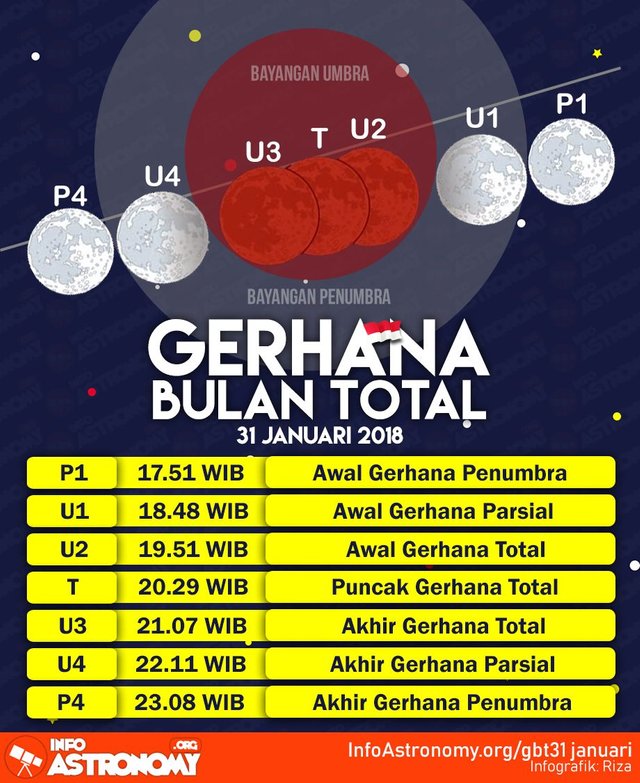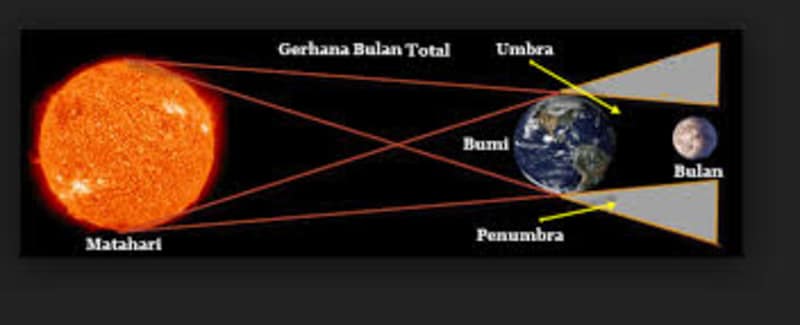Privileged Super Blue Blood Moon on January 31, 2018 (Bilingual)
Dear steemians. How are you today? I hope you are good.
January 2018 is one month of Astronomy. Why do I dare to call the month of Astronomy? This is not apart from the Astronomical phenomenon that occurred that month. The phenomenon occurs in some celestial bodies. One of the celestial bodies that experiencing the phenomenon of Astronomy is the moon.
The moon is a natural satellite that belongs to Earth. This satellite moves around the Earth with a period of not less than 29 days to once around the Earth. For Earth, the moon is the celestial body closest to it. In addition to close, also very loyal around the Earth. There are several Astronomical events involving the month during January 2018. The Astronomical events are as follows.
On January 2, 2018, the Moon was at perigee. The moon reaches the closest distance to Earth that is 355,565 km. Still on January 2nd, 2018, Full Moon.The moon will be above the horizon since the Sun sets until dawn arrives. Good chance to observe the Moon and its craters. After the full moon, the Moon will slowly shift as the sun rises over night. Full Moon January 2 as well as Full Moon Perigee because the Moon is at its closest distance to Earth. On January 9, 2018, End of Occupation Month. The moon rises midnight and sets at noon. The moon looks from midnight until dawn. On January 17, 2018, a New Month occurred. Time for observation. The sky will be dark without the light of the Moon. The right time to do astrophotography Deep Sky or the Milky Way. At this time, the Moon rises almost simultaneously with the rising of the Sun. So the Moon and the Sun will be visible all day long. Observers can enjoy the planets without the glare of the Moon. On January 15, 2018, Month at apogee point. The moon reaches the distance from Earth at a distance of 406,464 km. On January 25, 2018, Initial Activity Month. The moon will be visible since the Sun sets until midnight when the Moon sets. Observers of the sky can enjoy the light-free sky Moon from midnight until early morning. January 30, 2018, Month in perigee. The moon reaches its closest distance to Earth which is 358,994 km. On January 31, 2018, the Full Moon event occurred. The moon will be above the horizon since the Sun sets until dawn arrives. Good chance to observe the Moon and its craters. After the full moon, the Moon will slowly shift as the sun rises over night. Source

How does the process occur in the Blood Red Moon? As it is known that the events of the Full Moon on January 31, 2018, is also called the event of the Red Blood Moon. This is because at that time there is a Total Moon Eclipse that causes the moon is red blood. Therefore called the Red Blood Moon caused by the Earth's atmosphere mixing. The red blood moon occurs simultaneously with the supermoon, blue moon, and blood moon. This reason, that causes such Astronomical events is called very special and rare. Rare because it can only happen once every 150 years.
The Moon Total Eclipse event occurs when the Earth's position lies between the Moon and the Sun. At that moment the Moon's surface is exposed to the sun so that the entire surface of the moon facing Earth is clearly visible. If the position of the Sun, Earth and Moon are parallel, the sun's rays are blocked by the Earth. This event is called the lunar eclipse.
Actually, in the event of a lunar eclipse, often the moon can still be seen. This is because there is still the sunlight that is deflected into the moon by the earth's atmosphere. And most of these deflected rays have a spectrum of red light. That is why at the time of the lunar eclipse, the moon will look dark, can be red copper, orange, or brown. Source

The above explanation shows that in the lunar eclipse event we can see the moon. In fact we can see the moon with the naked eye or without the help of other optical tools. Although without the aid of optical tools but not harm the eyes of the observer. Happy observing Super Blue Blood Moon.
Keistimewaan Super Blue Blood Moon pada 31 Januari 2018
Bulan Januari 2018 merupakan salah satu bulan Astronomi. Mengapa saya berani menamakan sebagai bulan Astronomi? Hal ini tidak terlepas dari fenomena Astronomi yang terjadi pada bulan itu. Fenomena tersebut terjadi pada beberapa benda langit. Salah satu benda langit yang mengalami fenomena Astronomi adalah bulan.
Bulan merupakan sebuah satelit alami yang dimiliki Bumi. Satelit ini bergerak mengitari Bumi dengan periode tidak kurang dari 29 hari untuk sekali mengitari Bumi. Bagi Bumi, bulan adalah benda langit yang paling dekat dengannya. Selain dekat, juga sangat setia mengitari Bumi. Terdapat beberapa peristiwa Astronomi yang melibatkan bulan selama Januari 2018. Peristiwa Astronomi tersebut adalah sebagai berikut.
Pada tanggal 2 Januari 2018, Bulan di perigee. Bulan mencapai jarak terdekatnya dengan Bumi yakni 355.565 km. Masih tanggal 2 Januari 2018, Bulan Purnama. Bulan akan berada di atas cakrawala sejak Matahari terbenam sampai fajar tiba. Kesempatan baik untuk mengamati Bulan dan kawah-kawahnya. Setelah fase purnama, Bulan secara perlahan akan bergeser waktu terbitnya semakin malam. Bulan Purnama 2 Januari sekaligus juga Bulan Purnama Perigee karena Bulan sedang berada pada jarak terdekatnya dengan Bumi. Pada tanggal 9 Januari 2018, Bulan Perbani Akhir. Bulan terbit tengah malam dan terbenam siang hari. Bulan tampak dari tengah malam sampai jelang fajar. Pada tanggal 17 Januari 2018, terjadi Bulan Baru. Waktunya pengamatan. Langit akan gelap tanpa cahaya Bulan. Saat yang tepat untuk melakukan astrofotografi Deep Sky atau Bima Sakti. Pada saat ini, Bulan terbit hampir bersamaan dengan terbitnya Matahari. Jadi Bulan dan Matahari akan tampak sepanjang hari. Pengamat bisa menikmati planet-planet tanpa gangguan cahaya Bulan. Pada 15 Januari 2018, Bulan di titik apogee. Bulan mencapai jarak dari Bumi pada jarak 406.464 km. Pada tanggal 25 Januari 2018, Bulan Perbani Awal. Bulan akan tampak sejak Matahari terbenam sampai tengah malam saat Bulan terbenam. Para pengamat langit bisa menikmati langit bebas cahaya Bulan mulai tengah malam sampai jelang dini hari. Tanggal 30 Januari 2018, Bulan di perigee. Bulan mencapai jarak terdekatnya dengan Bumi yakni 358.994 km. Pada tanggal 31 Januari 2018, terjadi peristiwa Bulan Purnama. Bulan akan berada di atas cakrawala sejak Matahari terbenam sampai fajar tiba. Kesempatan baik untuk mengamati Bulan dan kawah-kawahnya. Setelah fase purnama, Bulan secara perlahan akan bergeser waktu terbitnya semakin malam. Source

Bagaimana proses terjadi Bulan Merah Darah? Sebagaimana diketahui bahwa peristiwa Bulan Purnama pada tanggal 31 Januari 2018 disebut juga peristiwa Bulan Merah Darah. Hal ini disebabkan karena pada saat itu terjadi Gerhana Bulan Total yang menyebabkan bulan berwarna merah darah. Oleh sebab itu disebut juga Bulan Darah Merah yang disebabkan adanya pembauran atmosfer Bumi. Bulan darah merah terjadi secara bersamaan dengan supermoon, blue moon, dan blood moon. Alasan ini yang menyebabkan peristiwa Astronomi tersebut disebut sangat istimewa dan langka. Langka karena peristiwa itu hanya bisa terulang 150 tahun sekali.
Peristiwa Gerhana Bulan Total terjadi saat posisi Bumi berada antara Bulan dan Matahari. Pada saat itu permukaan Bulan disinari oleh matahari sehingga seluruh permukaan bulan yang menghadap Bumi terlihat secara jelas. Jika posisi Matahari, Bumi dan Bulan sejajar maka sinar Matahari terhalang oleh Bumi. Peristiwa ini disebut dengan gerhana bulan.
Sebenarnya, pada peristiwa gerhana bulan, seringkali bulan masih dapat terlihat. Ini dikarenakan masih adanya sinar Matahari yang dibelokkan ke arah bulan oleh atmosfer bumi. Dan kebanyakan sinar yang dibelokkan ini memiliki spektrum cahaya merah. Itulah sebabnya pada saat gerhana bulan, bulan akan tampak berwarna gelap, bisa berwarna merah tembaga, jingga, ataupun coklat. Source

Penjelasan di atas menunjukkan bahwa pada peristiwa gerhana bulan kita dapat melihat bulan. Bahkan kita dapat melihat bulan dengan mata telanjang atau tanpa bantuan alat optic lainnya. Meskipun tanpa bantuan alat optic tetapi tidak membahayakan mata pengamat. Selamat mengamati Super Blue Blood Moon.
Reference
- http://www.infoastronomy.org/2017/10/persiapan-menyambut-gerhana-bulan-total-31-januari-2018.html
- https://langitselatan.com/2018/01/01/fenomena-langit-bulan-januari-2018/
- https://id.wikipedia.org/wiki/Gerhana_bulan
- https://kumparan.com/kabarpaspasuruan/langka-gerhana-bulan-total-akan-terjadi-di-penghujung-bulan-ini
@nkkb to @darmawanbuchari Terima kasih atas postingan yang panjang lebar ini. Dan urusan kita saya dah selesaikan . Satu utk 4
#nkkb
Terima kasih @nkkb. Senang dapat mengenal Anda. Salam kenal dari saya @darmawanbuchari
@nkkb to @darmawanbuchari Baik dan salam kenal.
@zublizainordin says @darmawanbuchari #dermawanbuchari Segenap Puji untuk Maha Pencipta kita. Terima Kasih kerana kongsi pos sedemikan bermakna.
#zublizainordin
Terima kasih @zublizainordin telah membaca postingan saya. Saya sangat menyukai Astronomi. Mari kita nikmati fenomena Astronomi ini.
Gure @darmawanbuchari jangan lupa malam besok kita amati gerhana di masjid Alue Awe.
Siap, guree. Jam berapa kita mulai.
setelah salat magrib
Malam singeh bektuwe ta sembahyang gerhana pak @darmawanbuchari
Malam singoh ikut mengamati di Alu Awe
@originalworks
@originalworks